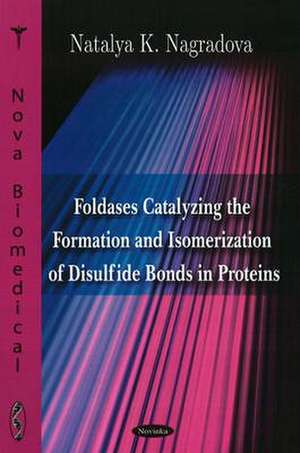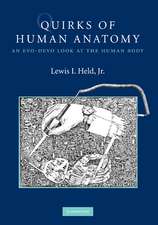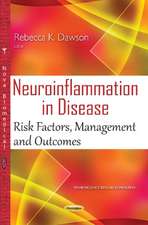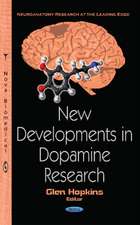Foldases Catalyzing the Formation and Isomerization of Disulfide Bonds in Proteins
Autor Natalya K. Nagradovaen Limba Engleză Paperback – 31 mar 2009
Preț: 226.17 lei
Preț vechi: 308.64 lei
-27% Nou
Puncte Express: 339
Preț estimativ în valută:
43.29€ • 47.04$ • 36.39£
43.29€ • 47.04$ • 36.39£
Carte disponibilă
Livrare economică 31 martie-14 aprilie
Preluare comenzi: 021 569.72.76
Specificații
ISBN-13: 9781606924662
ISBN-10: 1606924664
Pagini: 75
Ilustrații: tables, charts & illus
Dimensiuni: 153 x 226 x 7 mm
Greutate: 0.17 kg
Editura: Nova Science Publishers Inc
ISBN-10: 1606924664
Pagini: 75
Ilustrații: tables, charts & illus
Dimensiuni: 153 x 226 x 7 mm
Greutate: 0.17 kg
Editura: Nova Science Publishers Inc
Cuprins
Preface; Introduction; Eukaryotic Protein Disulfide Isomerase (PDI); The Role of Protein Disulfide Isomerase in the Endoplasmic Reticulum; Modular Organization of the PDI Molecule and the Role of Different Domains; Functional Properties of PDI Active CentersThe pKa Values of Essential Cysteine Residues; Disulfide Isomerization: The Essential Function of PDI; The Most Significant Cellular Function of PDI Is the Isomerization of Non-Native Disulfide Bonds; The Mechanism of the Isomerization Reaction Catalyzed by PDI Depends on the Structure of Protein Substrate; Relationship between the Overall Structure of PDI Molecule and Its Activity as a Protein Disulfide Isomerase; Is PDI Capable of Discriminating between Native and Non-Native Disulfides?; Dithiol Oxidation Catalyzed by PDI; Ero1p: An Enzyme Producing Disulfide Bonds for Oxidative Protein Folding in the Endoplasmic Reticulum; The Evidence that Oxidizing Equivalents Flow from Ero1p to Substrate Proteins via PDI; The Mechanism of Ero1p Oxidative Activity in Protein Disulfide Bond Formation; The X-Ray Crystal Structure of Ero1p Reveals the Spatial Relationship between Functional Cysteines and the Bound FAD; Two Catalytic Centers of PDI Are Not Equivalent; The Role of Glutathione in Oxidative Protein Folding in Endoplasmic Reticulum; Oxidized Glutathione Does Not Provide the Oxidation Equivalents Necessary for the Formation of Disulfide Bonds; GSH Imported into the Endoplasmic Reticulum from Cytosol Can Directly Reduce PDI; Disulfide Bond Formation and Isomerization in Prokaryotes; A Pathway for Disulfide Bond Formation in the Periplasm; DsbA, a Catalyst in Disulfide Bond Formation; DsbB, a Protein Responsible for Reoxidation of DsbA; Similarities in Prokaryotic and Eukaryotic Disulfide Bond-Forming Pathways; A Pathway for Disulfide Bond Isomerization in the Periplasm; DsbC, a Disulfide Isomerase; Dimerization of DsbC Is a Prerequisite for Its Isomerase Activity; Dimerization of DsbC Protects Its Active Sites from Oxidation by DsbB; DsbG, a Paralogue of DsbC; DsbD, a Recycler of Reduced DsbC and DsbG; How Does DsbD Work?; Conclusion; Index.
















